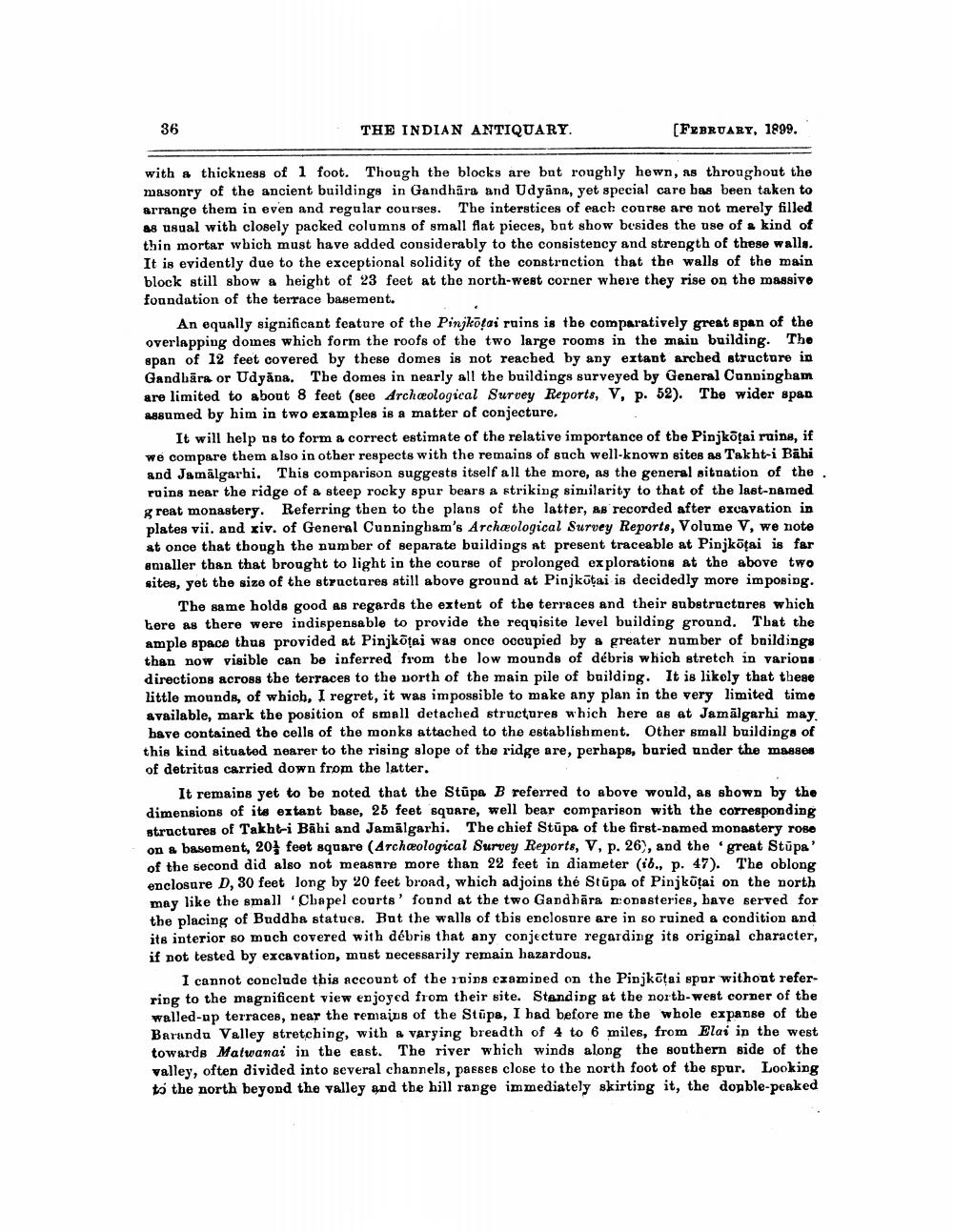________________
36
THE INDIAN ANTIQUARY.
(FEBRUARY, 1899.
with & thickness of 1 foot. Though the blocks are but roughly hewn, as throughout the masonry of the ancient buildings in Gandhāra and Udyāna, yet special care has been taken to arrange them in even and regular courses. The interstices of each course are not merely filled As usual with closely packed columns of small flat pieces, but show besides the use of a kind of thin mortar which must have added considerably to the consistency and strength of these walls. It is evidently due to the exceptional solidity of the construction that the walls of the main block still show a height of 23 feet at the north-west corner where they rise on the massive foundation of the terrace basement.
An equally significant feature of the Pinjkõțai ruins is the comparatively great span of the overlapping domes which form the roofs of the two large rooms in the main building. The span of 12 feet covered by these domes is not reached by any extant arcbed structure in Gandbārs or Udyana. The domes in nearly all the buildings surveyed by General Canningham are limited to about 8 feet (see Archeological Survey Reports, V, p. 52). The wider span assumed by him in two examples is a matter of conjecture.
It will help us to form a correct estimate of the relative importance of the Pinjkötai ruins, if We compare them also in other respects with the remains of such well-known sites as Takht-i Bābi and Jamälgarhi. This comparison suggests itself all the more, as the general situation of the .
ruins near the ridge of a steep rocky spur bears a striking similarity to that of the last-named great monastery. Referring then to the plans of the latter, as recorded after excavation in plates vii. and xiv. of General Cunningham's Archæological Survey Reports, Volume V, we note at once that though the number of separate buildings at present traceable at Pinjkõțai is far smaller than that brought to light in the course of prolonged explorations at the above two sites, yet the size of the structures still above ground at Pinjkutai is decidedly more imposing.
The same holds good as regards the extent of the terraces and their substructures which bere as there were indispensable to provide the requisite level building ground. That the ample space thus provided at Pinjkõtaj was once occupied by a greater number of buildings than now visible can be inferred from the low mounds of débris which stretch in various directions across the terraces to the vorth of the main pile of building. It is likely that these little mounds, of which, I regret, it was impossible to make any plan in the very limited time available, mark the position of small detached structures which here as at Jamälgarhi may have contained the cells of the monks attached to the establishment. Other small buildings of this kind situated nearer to the rising slope of the ridge are, perhaps, buried under the masses of detritas carried down from the latter.
It remains yet to be noted that the Stúpa B referred to above would, as shown by the dimensions of its extant base, 25 feet square, well bear comparison with the corresponding structures of Takht-i Bāhi and Jamälgarhi. The chief Stupa of the first-named monastery rose on & basement, 20 feet square (Archeological Survey Reports, V, p. 26), and the great Stūpa' of the second did also not measure more than 22 feet in diameter (6., p. 47). The oblong enclosure D, 30 feet long by 20 feet broad, which adjoins thé Stupa of Pinjkūtai on the north may like the small 'Chapel courts' found at the two Gandhāra monasteries, bave served for the placing of Buddha statues. But the walls of this enclosure are in so ruined a condition and its interior so much covered with débris that any conjecture regarding its original character, if not tested by excavation, must necessarily remain hazardous.
I cannot conclude this account of the dins examined on the Pinjkotai spor without referring to the magnificent view enjoyed from their site. Standing at the north-west corner of the walled-up terraces, near the remains of the Stupe, I had before me the whole expanse of the Baranda Valley stretching, with a varying breadth of 4 to 6 miles, from Elai in the west towards Matwanai in the east. The river which winds along the southern side of the valley, often divided into several channels, passes close to the north foot of the spur. Looking to the north beyond the valley and the hill range immediately skirting it, the double-peaked




